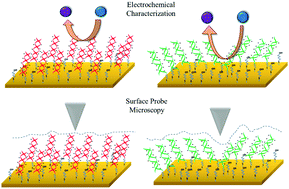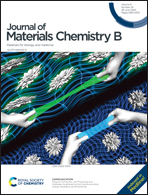Unique sequence-dependent properties of trinucleotide repeat monolayers: electrochemical, electrical, and topographic characterization†
Abstract
Trinucleotide repeat (TNR) sequences widely exist in nature and their overgrowth is associated with two dozen neurodegenerative diseases in humans. These sequences have a unique helical flexibility, which affects their biophysical properties. A number of biophysical properties of these sequences have been studied in the past except their surface-tethered monolayers. To address the effect of sequence context and the associated helical flexibility on TNR monolayers, disease-relevant TNRs from three flexibility groups were surface-assembled on gold surfaces. The properties of the TNR films were studied, including charge transfer resistance (Rct) by electrochemical impedance spectroscopy (EIS), surface density by chronocoulometry (CC), surface topography by atomic force microscopy (AFM), and electrical conductivity by conducting atomic force microscopy (C-AFM). We found that the TNR film properties are characteristically sequence dependent rather than being dependent on their flexibility rank reported in the literature. The characteristic properties of TNR films studied here may be used for engineering label-free biosensors to detect neurological disorders and build DNA bioelectronics.



 Please wait while we load your content...
Please wait while we load your content...